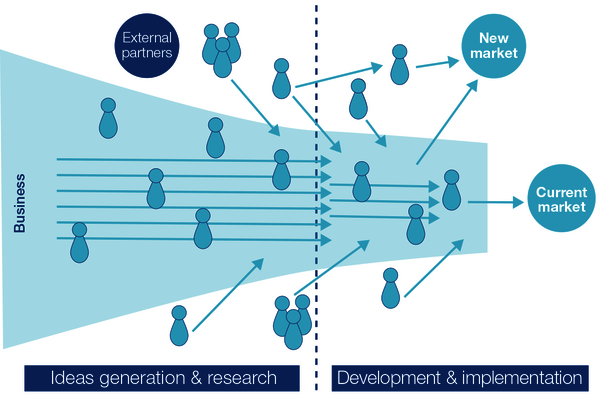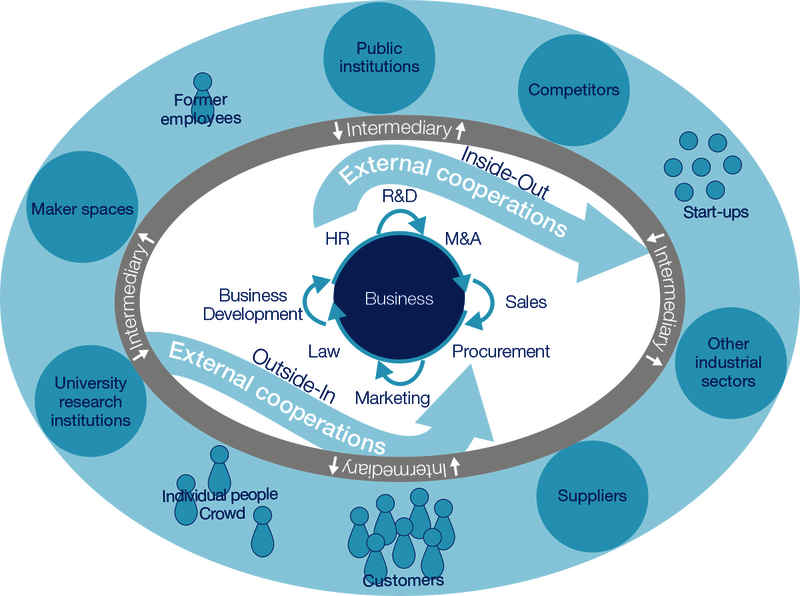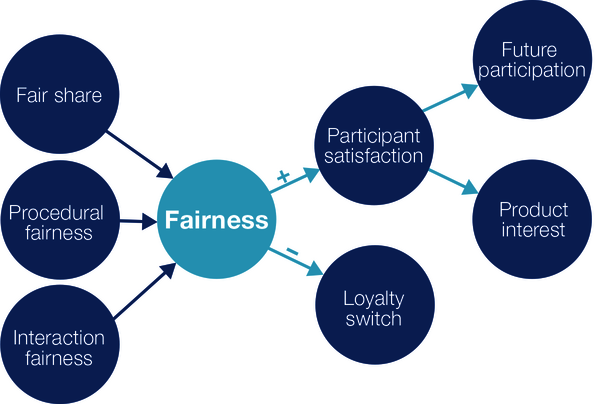Fair Open Innovation
The benefits of an open innovation culture
Just imagine the new opportunities that would arise for your enterprise and your products of you could integrate people as idea providers, concept developers or even implementers in the design of your innovations, independent of their origin!
With this you could mobilise additional resource, gain new knowledge within the organisation, discover new collaborative partners or even future employees and develop networks.
What is Open Innovation?
Open innovation is defined by opening the organisational boundaries of the company. This offers organisations the opportunity of an inflow of expertise from outside, or even the creation of new opportunities for use, not previously considered.
Strengthen own developments
With outside-in innovations, the enterprise opens itself up to external innovators or market information groups to obtain market information, ideas, solutions, technologies or feedback. The integration of external knowledge extends the thought-horizon with the interdisciplinary development of new solutions. The extended access to external resources also opens the option to reduce innovative risk.
Through the inclusion of customers, user experiences and needs are gathered directly from the market. With this, the direction and development of a solution can occur close to the market and increases the rate of success.
Digital crowdsourcing platforms network interested user circles and the previously dormant knowledge, expertise and skills are made visible.
In an ideal scenario, personnel recruiting measures can even be derived from this.
Open Innovation help to positively influence marketing and the visibility of innovation initiatives by, for example, presenting new projects to different stakeholders.
New opportunities for own developments
With inside-out open innovations, the enterprise tries to share existing internal knowledge with the external environment and, as a result, new,external sales opportunities for the utilisation of own technologies can be found and/or technologies even outside the current business model can be utilised. This can lead to establishing spin-offs or to out-licensing.
Inside-Out Open Innovations can boost the growth of whole markets, which benefits every market participant within the respective area.
Innovation culture
The innovation activity within an enterprise is determined, to a large extent, by an innovation-promoting culture. This culture is above all characterised by management, which can contribute through the exemplification of values and the disposition of resources to the development of an innovation culture. Through the activation of internal and external resources, management can strengthen the integration service of an enterprise and force a quick transfer of innovations into marketable products. A modern enterprise culture permits experiments and failures, can deal with uncertainty and errors, and ensures purposefully to use the external knowledge profitably.
The handling of their own intellectual property and that of innovation partners plays a crucial role in this. This must be clearly defined and made transparent for all.
To enter into the matter of Open Innovation, you should therefore ask the question at the outset: how will opening the innovation process and the integration of external partners fit in with the active handling of knowledge, and what measures are required?
Is our enterprise ready for Open Innovation?
Open Innovation begins with the correct attitude - success is dependent on the right capabilities and tools.
- Do the business model and the legal framework conditions allow an enterprise opening?
- Does the enterprise have an appropriate culture and a partnership approach?
- Do the enterprise’s internal guidelines and processes fit?
- Can the employees and the enterprise resources support Open Innovation activities?
- Can all partners benefit from success?
Questions like this will help to decide whether Open Innovation methods can provide the enterprise with approaches promising of success and the need for adaptation necessitated in an area.
Open Innovation Partners
A number of different, external partners can contribute to a functioning Open Innovation ecosystem:
- Research facilities, like universities
- Customers
- Suppliers
- Individual and former employees
- Competitors
- SMEs from different fields of industry
- Start-ups
All of these partner can provide valuable contributions through their collaboration in the development market launch of new products or services.
Relevant service providers and platform operators provide the necessary assistance, particularly in the beginning of an enterprise’s reorientation through to the open innovation processes.
Fairness in Open Innovation
The successful and sustainable inclusion of external innovators requires both fair and transparent framework conditions, as well as an appropriate acknowledgement of the contribution to the competitive advantage obtained.
With an open innovation collaboration there is the risk that actors feels as though their contribution has not be viewed accordingly or recognised. It is therefore important to understand that open innovation is not a way to get something without giving something in return.
One of the central options for motivation and corporate loyalty is to award all contributions with “fair remuneration” (“distribution fairness”). The perception of fairness is however, furthermore determined by how transparent and consistent the processes (e.g. selection processes) are designed (“procedural fairness”) and that the interaction with the community is quick, authentic and appreciative (“interaction fairness”).
The distribution fairness is defined by the principle of fairness in which one person views the relationship of their input and the output received as fair.
Depending on the type of challenges of the innovation initiative, remunerations should be defined, e.g. cash prizes, material prizes, placements, presentation of the winner’s name or an invitation to the further development of the idea or offered as part of the organisation. Awarding of small cash prizes for, e.g. ground-breaking innovations, is definitely inadequate.
Even visibility within the community is viewed as a type of recognition for the user’s efforts and promotes the attractiveness of the project. Depending on the target group, some actors feel that a career-related payment is more profitable and motivating than simply a cash prize.
Alongside the payment as such, the process of awarding, procedural justice, is another important determinant of perceived fairness.
The procedural fairness is the perceived justice of the procedure, the guidelines and the criteria used by the decision makers in achieving the results. The following aspects are important in this:
(1) Consistency - selection procedure should be comprehensively coherent,
(2) Freedom from prejudice - the personal self-interest of the decision maker should not play a role,
(3) Accuracy - the quality of the information and criteria used in the selection process,
(4) Correction - the opportunity to adapt unfair decisions,
(5) Representation - requirements, values and perspectives of all parties affected by the selection process should be represented in the process,
(6) Ethics – the selection must be in agreement with the fundamental moral and ethical values of the observer.
Interaction justice refers to the human side, the way in which communication between the source and the receiver of justice occurs and is dependent on the interpersonal conduct elements, such as politeness, honesty and respect. This type of justice is promoted when the decision maker treats individuals with respect and sensitivity, and they thoroughly explain the reasons for their decisions.
[Graphic and translation of quotes from Faullant, Füller, Hutter, Gebauer, 2011; adapted]
Reading tips and sources
What is Open Innovation?
- Chesbrough, Henry (2020): “To recover faster from Covid-19, open up: Managerial implications from an open innovation perspective”, Industrial Marketing Management; online at: https://doi.org/10.1016/j.indmarman.2020.04.010
- Chesbrough, Henry (2019): "Open innovation results: Going beyond the hype and getting down to business", Oxford University Press
- Hippel, Eric von (2017): "Free Innovation", MIT Press; online at: https://ssrn.com/abstract=2866571
- Mielert, Stefanie; Piira, Kathrin (2016): “Open Innovation – Garant für Entwicklungen von morgen”, duz 11/2016. Online at: https://www.wissenschaftsmanagement-online.de/system/files/downloads-wimoarticle/duzM1116_PRAXISLEITEN_Open_Innovation.pdf
- Chesbrough, Henry; Bogers, Marcel (2014): “Explicating Open Innovation : Clarifying an Emerging Paradigm for Understanding Innovation”
- Henry Chesbrough, Henry; Vanhaverbeke, Wim; West, Joel (2014): “New Frontiers in Open Innovation., Oxford University Press, 2014. p. 3-28.
- Esseiva, Olivier (2013): “Value Creation and Value Capture in Open Innovation” – (Master’s thesis)
- ACE Allied Consultants Europe (2012): “A comprehensive guide to Efficient Open Innovation”; http://www.space-consulting.eu/media/publications/efficient-open-innovation.pdf
- Habicht, H., Möslein, K.M., Reichwald, R., (2011): “Open Innovation: Grundlagen, Werkzeuge, Kompetenzentwicklung”, Information Management & Consulting 1/2011, p. 44-51.
- Chesbrough, Henry (2003): “Open Innovation”
- THE LAW AND MANAGEMENT OF INTELLECTUAL PROPERTY IN OPEN INNOVATION ECOSYSTEMS, Saleh Al-Sharieh, Anne-Laure https://oi-net.eu/m-oinet-network/m-oinet-key-topics/m-wp5-common-curricula-framework/982-coming-soon-innovation-education-reloaded-nurturing-skills-for-the-future
Open Innovation Readiness
- Bevis, Keith, Cole, Adrian. (2018): “Open Innovation Readiness: a Tool”,
https://pdfs.semanticscholar.org/aa5b/459b26293068d158b73137839c570af48e36.pdf
https://www.researchgate.net/publication/228435861_Open_Innovation_Readiness_a_Tool - Nesta, 100% open innovation readiness test
http://www.100open.com/toolkit/open-organisation-test/
https://media.nesta.org.uk/documents/100_open_innovation_readiness_test.pdf - Philipp Wagner, Prof. Frank Piller C (2012): “Increasing innovative capacity: is your company ready to benefit from open innovation processes?”, Ernst & Young Performance Journal, Volume 4, Issue 2; online at:
https://pdfs.semanticscholar.org/70c3/f6ec83cc12adf39789a083d069202f8e9cd4.pdf - Diener, Kathleen ,Piller, Frank (2010): “The Market for Open Innovation Increasing the efficiency and effectiveness of the innovation process”; online at:
https://www.researchgate.net/publication/272566648_The_Market_for_Open_Innovation_Increasing_the_efficiency_and_effectiveness_of_the_innovation_process - “Bereit für Open Innovation?” (Project example Fraunhofer)
https://www.iao.fraunhofer.de/lang-de/presse-und-medien/aktuelles/1721-bereit-fuer-open-innovation.html
Fairness in Open Innovation
- de Beer, J., McCarthy, I., Soliman, A., Treen, E. (2017): “Click here to agree: Managing intellectual property when crowdsourcing solutions”, Business Horizons, Volume 60, Issue 2, March–April 2017, Pages 207-217
- Faullant, R., Füller, J., Hutter, K., Gebauer, J. (2011): “Fair Play: Perceived fairness in idea and design contest communities and its behavioral consequences” Paper presented at 18th International Product Development Management Conference
- Faullant, R., Fueller, J., Hutter, K. (2017): “Fair play: Perceived fairness in crowdsourcing competitions and the customer relationship-related consequences”, Management Decision, Vol. 55 Issue: 9, pp.1924-1941, online: https://doi.org/10.1108/MD-02-2017-0116
- Franke, N., Keinz, P., Klausberger, K. (2013) “Does This Sound Like a Fair Deal?”: Antecedents and Consequences of Fairness Expectations in the Individual’s Decision to Participate in Firm Innovation, Organization Science 24(5), p. 1495–1516
- Fair Crowd Work - Gewerkschaftliche Informationen und Austausch zu Crowd-, App- und plattformbasiertem Arbeiten“, online: http://faircrowd.work/de/




